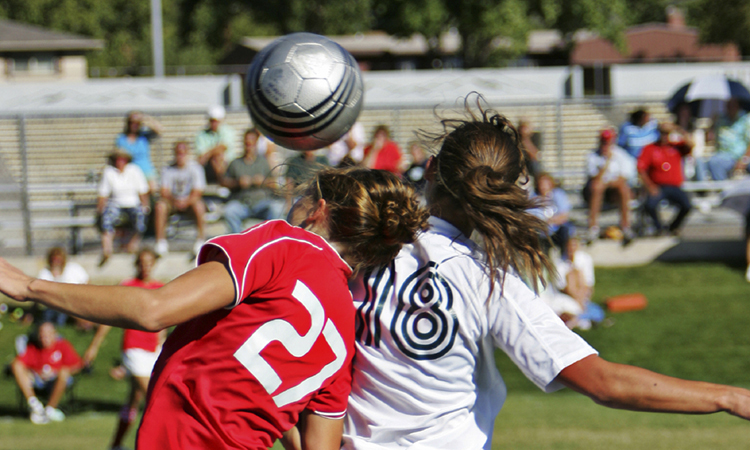
Soccer is the most popular team sport in the world, offering leagues and options for all age groups and genders. The number of soccer players in the U.S. has been steadily increasing, reaching almost 16 million regular soccer players in 2017. With more and more people playing soccer, it is not surprising that the number of soccer-related injuries are also increasing – especially as children get older and level of play intensifies. Nearly 240,000 athletes were treated in emergency rooms for soccer-related injuries in 2012. The most common sports injuries seen from soccer are sprains and strains, lower extremity ligament injuries, and overuse injuries.
Sprains and Strains
Sprains and strains are the most common lower extremity injury seen in soccer players, and their severity can vary from minor to severe. These injuries are commonly seen in the knee and ankle, however, other areas can also be affected. According to the U.S. Soccer Federation, lateral ankle sprains and hamstring muscle strains are the top two injuries. A strain occurs when damage is done to muscles or tendons as a result of being pulled or stretched too far. A sprain occurs when ligaments are stretched beyond their limit, or even torn.
Ligament Injuries
One of the most talked about soccer injuries (especially among middle school and high school age females) is anterior cruciate ligament (ACL) injuries. These injuries can be caused by collision or contact, but are most often the result of landing from a jump incorrectly, stopping suddenly, or rapidly changing direction. While most sprains or strains will heal themselves, a torn ACL will not and usually requires surgery.
Overuse Injuries
Overuse injuries occur frequently in regular soccer players, including Achilles tendinitis, shin splints, and stress fractures. An overuse injury is any type of muscle or joint injury that is caused by repetitive trauma, and can stem from training errors or technique errors. Many younger athletes are choosing to focus on one sport and are training year-round, and doctors are seeing an increase in overuse injuries.
Other Injuries
Cuts, bruises, and fractures may also be seen in soccer players due to player collisions or other contact. Injuries to the upper extremities like the hand, wrist, and shoulder can happen and usually occur from falling or player-to-player contact. It is rare to sustain a head injury from heading the ball, but concussions often occur as a result of contact with another player or the head hitting the ground or goalpost.
Tips to Prevent Soccer Injuries
- Always warm up and stretch. Studies show that cold muscles are more prone to injury. Warm up with exercises like jumping jacks, or running or walking in place, then slowly and gently stretch.
- Stretching after a game or practice is often neglected. Stretching will help reduce muscle soreness and keep the muscles flexible.
- Drink water! Even mild levels of dehydration can effect athletic performance, and your body will not be able to effectively cool itself through sweat and evaporation.
- Maintain your fitness and conditioning. During the off-season, stick to a balanced fitness program. If you feel out of shape at the beginning of the season, gradually increase your activity level and slowly build back up to a higher fitness level.
- Wear appropriate equipment and gear, including shin guards, cleats, and use the appropriate soccer ball.
- Limit the number of teams your child is playing on in one season. Children who play on more than one team are at a greater risk for overuse injuries.
- Pay attention to weather conditions. In a thunderstorm, leave the field and move inside. In hot weather, be sure to take sufficient breaks. In cold weather, wear appropriate clothing and layers including gloves and hats.
If you suffer an injury playing soccer that does not improve over time, or does not improve with the use of rest, ice, and anti-inflammatory medications, it’s time to schedule an appointment with an orthopedic specialist. When a player is injured, their symptoms should be completely gone before returning to play to prevent further injury. The athlete must have no pain, no swelling, full range of motion, and normal strength. If a player has suffered a concussion, they must have no symptoms at rest or with exercise, and should be cleared by a medical provider before returning to play.





